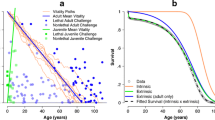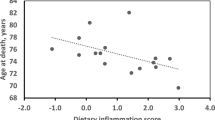Abstract
Survival is a key demographic characteristic in many areas including both human demography and population ecology. However, it is often the case that data collection protocols are different in these areas, resulting in different models and methods of analysis. This paper is motivated for the different emphasis given to the elicitation of the temporal scale (and consequently, on the origin time) in ecological and medical survival studies. Specifically, in medical studies, the origin time is often determined in advance with individuals followed over a period of time at regular (or irregular) intervals, thus focusing on time within study (or age to a given reference point). However, in ecological capture–recapture studies, the capture occasions are typically fixed in advance, with an imperfect detection process observing individuals at these times. Moreover, the temporal scale is often primarily specified at the capture occasion level. In this work we focus on an ecological capture–recapture study related to guillemots and compare and contrast two different temporal scales: (1) calendar (or capture occasion); and (2) age (or time within study), in terms of the way the data may be represented and in relation to the ecological Cormack–Jolly–Seber-type model. The different temporal scales provides insights into the different underlying structures, which can then be combined into a joint (calendar and age) dependence model.




Similar content being viewed by others
References
Bonner SJ, Schwarz CJ (2006) An extension of the Cormack–Jolly–Seber model for continuous covariates with application to Microtus pennsylvanicus. Biometrics 62:142–149
Borchers DL, Efford MG (2008) Spatially explicit maximum likelihood methods for capture–recapture studies. Biometrics 64:377–85
Brooks SP, Catchpole EA, Morgan BJ (2000) Bayesian animal survival estimation. Stat Sci 15(4):357–376
Brownie C, Hines JE, Nichols JD, Pollock KH, Hestbeck JB (1993) Capture-recapture studies for multiple strata including non-Markovian transitions. Biometrics 49:1173–1187
Burnham K (1993) A theory for combined analyis of ring recovery and recapture data. In: Lebreton J, North PM (eds) Marked individuals in the study of bird population. Birkhuser Verlag, Basel, pp 199–213
Catchpole EA, Morgan BJT (1996) Model selection in ring-recovery models using score tests. Biometrics 52(2):664–672
Catchpole E, Freeman SN, Morgan BJT, Harris MP (1998) Integrated recovery/recapture data analysis. Biometrics 54:33–46
Cheung YB, Gao F, Khoo KS (2003) Age at diagnosis and the choice of survival analysis methods in cancer epidemiology. J Clin Epidemiol 56(1):38–43. https://doi.org/10.1016/S0895-4356(02)00536-X
Christensen R, Johnson W, Branscum A, Hanson TE (2011) Bayesian ideas and data analysis: an introduction for scientists and statisticians. CRC Press, Boca Raton
Cole DJ, Morgan BJ, Titterington D (2010) Determining the parametric structure of models. Math Biosci 228(1):16–30
Cormack R (1964) Estimates of survival from the sighting of marked animals. Biometrika 51:429–438
Crespin L, Harris MP, Lebreton JD, Frederiksen M, Wanless S (2006) Recruitment to a seabird population depends on environmental factors and on population size. J Anim Ecol 75(1):228–238
Croxall J, Rothery P (1991) Population regulation of seabirds: implications of their demography for conservation. Bird population studies: relevance to conservation and management. Oxford University Press, Oxford, pp 272–296
Freeman SN, Morgan BJT (1992) A modelling strategy for recovery data from birds ringed as nestlings. Biometrics 48(1):217–235
Giménez O, Rossi V, Choquet R, Dehais C, Doris B, Varella H, Vila JP, Pradel R (2007) State-space modelling of data on marked individuals. Ecol Model 206(3):431–438
Giménez O, Morgan BJ, Brooks SP (2009) Weak identifiability in models for mark-recapture-recovery data. In: Thomson DL, Cooch EG, Conroy MJ (eds) Modeling demographic processes in marked populations. Springer, Berlin, pp 1055–1067
Golchi S (2016) Informative priors and Bayesian computation. In: 2016 IEEE international conference on data science and advanced analytics (DSAA), pp 782–789
Harris MP, Wanless S, Rothery P, Swann RL, Jardine D (2000) Survival of adult common guillemots uria aalge at three scottish colonies. Bird Study 47(1):1–7
Harris MP, Frederiksen M, Wanless S (2007) Within-and between-year variation in the juvenile survival of Common Guillemots Uria aalge. Ibis 149(3):472–481
Hougaard P (2000) Analysis of multivariate survival data. Springer, Berlin
Jolly G (1965) Explicit estimates from capture-recapture data with both death and immigration-stochastic model. Biometrika 52:225–247
King R (2014) Statistical ecology. Annu Rev Stat Appl 1(1):401–426. https://doi.org/10.1146/annurev-statistics-022513-115633
King R, Brooks SP (2003) Closed form likelihoods for Arnason–Schwarz models. Biometrika 90:435–444
King R, McCrea RS (2014) A generalised likelihood framework for partially observed capturerecapturerecovery models. Stat Methodol 17:30–45. https://doi.org/10.1016/j.stamet.2013.07.004. http://www.sciencedirect.com/science/article/pii/S1572312713000609. Modern statistical methods in ecology
King R, Langrock R (2016) Semi-Markov Arnason–Schwarz models. Biometrics 72:619–628
King R, Brooks SP, Coulson T (2008) Analysing complex capture–recapture data: incorporating time-varying covariate information. Biometrics 64:1187–1195
King R, Morgan B, Giménez O, Brooks S (2010) Bayesian analysis for population ecology. CRC Press, Boca Raton
Kom E, Graubard B, Midthune D (1997) Time-to-event analysis of longitudinal follow-up of a survey: choice of the time-scale. Am J Epidemiol 145(1):72–80
Lamarca R, Alonso J, Gómez G, Muoz Á (1998) Left-truncated data with age as time scale: an alternative for survival analysis in the elderly population. J Gerontol Ser A 53A(5):337–343. https://doi.org/10.1093/gerona/53A.5.M337
Langrock R, King R (2013) Maximum likelihood estimation of markrecapturerecovery models in the presence of continuous covariates. Ann Appl Stat 7(3):1709–1732
Lebreton J, Burnham K, Clobert J, Anderson D (1992) Modeling survival and testing biological hypothesis using marked animals: a unified approach with case studies. Ecol Monogr 62:67–118
McCarthy MA, Masters P (2005) Profiting from prior information in Bayesian analyses of ecological data. J Appl Ecol 42:1012–1019
McCrea R, Morgan B (2015) Analysis of capture–recapture data. CRC Press, Boca Raton
Morgan BJT, Freeman SN (1989) A model with first-year variation for ring-recovery data. Biometrics 45:1087–1102
Morrison KW, Hipfner JM, Gjerdrum C, Green DJ (2009) Wing length and mass at fledging predict local juvenile survival and age at first return in tufted puffins. The Condor 111(3):433–441
Newman K, Buckland S, Morgan B, King R, Borchers D, Cole D, Besbeas P, Gimenez O, Thomas L (2014) Modelling population dynamics. Springer, Boca Raton
Pledger S, Efford M, Pollock KH, Collazo JA, Lyons JE (2009) Stopover duration analysis with departure probability dependent on unknown time since arrival. In: Thomson DL, Cooch EG, Conroy MJ (eds) Modeling demographic processes in marked populations. Springer, Berlin, pp 349–363
Plummer M (2003) JAGS: a program for analysis of Bayesian graphical models using Gibbs sampling. In: Proceedings of the 3rd international workshop on distributed statistical computing, vol 124, pp 1–9
Pradel R (2005) Multievent: an extension of multistate capture–recapture models to uncertain states. Biometrics 61:442–447
R Core Team (2020) R: a language and environment for statistical computing. R Foundation for Statistical Computing, Vienna, Austria. https://www.R-project.org/
Robert C, Casella G (2011) A short history of Markov chain Monte Carlo: subjective recollections from incomplete data. Stat Sci 26(1):102–115
Royle JA (2008) Modeling individual effects in the Cormack–Jolly–Seber model: a state-space formulation. Biometrics 64(2):364–370
Sarzo B, Armero C, Conesa D, Hentati-Sundberg J, Olsson O (2019) Bayesian immature survival analysis of the largest colony of common murre Uria aalge in the Baltic sea. Waterbirds 42(3):304–313
Schwarz CJ, Schweigert JF, Arnason AN (1993) Estimating migration rates using tag-recovery data. Biometrics 49:177–193
Seber G (1965) A note on the multiple recapture census. Biometrika 52:249–259
Seber G, Schofield M (2019) Capture–recapture: parameter estimation for open animal Populations. Springer, Berlin
Votier SC, Birkhead TR, Oro D, Trinder M, Grantham M, Clark JA, McCleery RH, Hatchwell BJ (2008) Recruitment and survival of immature seabirds in relation to oil spills and climate variability. J Anim Ecol 77(5):974–983
Westreich D, Cole SR, Tien PC, Chmiel JS, Kingsley L, Funk MJ, Anastos K, Jacobson LP (2010) Time scale and adjusted survival curves for marginal structural Cox models. Am J Epidemiol 171(6):691–700. https://doi.org/10.1093/aje/kwp418
Acknowledgements
Blanca Sarzo has a research Grant (BES-2014-070766) supported by MTM2013-42323-P from the Spanish Ministry of Economy and Competitiveness. This work has been partially supported by Grants MTM2016-77501-P and TEC2016-81900-REDT from the Spanish Ministerio de Ciencia, Innovación y Universidades. Agencia Estatal de Investigación (jointly financed by the European Regional Development Fund, FEDER). RK was funded by a Leverhulme Research Fellowship. Field work on Stora Karlsö has been made possible through a long-term engagement in the Baltic Seabird project by WWF Sweden. We thank a large number of field workers and volunteers at Stora Karlsö in the period 2006–2016 for support with ringing and observation studies. Karlsö Jagt-och Djurskyddsfrenings AB provided logistical support.
Author information
Authors and Affiliations
Corresponding author
Ethics declarations
Conflict of interest
The authors declare that they have no conflict of interest.
Additional information
Publisher's Note
Springer Nature remains neutral with regard to jurisdictional claims in published maps and institutional affiliations.
Appendix
Appendix
In order to highlight differences in data presentation when using both temporal scales and for reproducibility issues, here we present the ten cohort m-arrays in age scale (Tables 8, 9, 10, 11, 12, 13, 14, 15, 16, 17) and the four age m-arrays in calendar scale (Tables 18, 19, 20, 21), corresponding to the study database.
Rights and permissions
About this article
Cite this article
Sarzo, B., Conesa, D. & King, R. Cormack–Jolly–Seber models: time and age perspectives. Stoch Environ Res Risk Assess 34, 1683–1698 (2020). https://doi.org/10.1007/s00477-020-01840-x
Published:
Issue Date:
DOI: https://doi.org/10.1007/s00477-020-01840-x




